The Origin and Evolution of Ore-Bearing Rocks in the Loypishnun Deposit (Monchetundra Massif, NE Fennoscandian Shield): Isotope Nd-Sr and REE Geochemical Data
Abstract
1. Introduction
2. Geological Settings
3. Materials and Methods
3.1. Sm-Nd Method
3.2. Rb-Sr Method
4. Results
4.1. Petrography
4.2. PGE Content
4.3. Whole Rocks Geochemistry
4.4. Nd-Sr Isotope Composition
5. Discussion
Supplementary Materials
Author Contributions
Funding
Acknowledgments
Conflicts of Interest
References
- Bayanova, T.; Ludden, J.; Mitrofanov, F. Timing and duration of Palaeoproterozoic events producing ore-bearing layered intrusions of the Baltic Shield: Metallogenic, petrological and geodynamic implications. Geol. Soc. Lond. Spec. Publ. 2010, 323, 165–198. [Google Scholar] [CrossRef]
- Mitrofanov, F.P.; Bayanova, T.B.; Korchagin, A.U.; Groshev, N.Y.; Malitch, K.N.; Zhirov, D.V.; Mitrofanov, A.F. East Scandinavian and Noril’sk plume mafic large igneous provinces of Pd-Pt ores: Geological and metallogenic comparison. Geol. Ore Depos. 2013, 55, 305–319. [Google Scholar] [CrossRef]
- Layered Intrusions of Monchegorsk Ore Region: Petrology, Ore-Forming, Isotopy, Deep Structure; Mitrofanov, F., Smolkin, V., Eds.; KSC RAS: Apatity, Russia, 2004; p. 177. [Google Scholar]
- Yang, S.-H.; Hanski, E.; Li, C.; Maier, W.D.; Huhma, H.; Mokrushin, A.V.; Latypov, R.; Lahaye, Y.; O’Brien, H.; Qu, W.-J. Mantle source of the 2.44–2.50 Ga mantle plume-related magmatism in the Fennoscandian Shield: Evidence from Os, Nd, and Sr isotope compositions of the Monchepluton and Kemi intrusions. Miner. Depos. 2016, 51, 1055–1073. [Google Scholar] [CrossRef]
- Nerovich, L.I.; Bayanova, T.B.; Savchenko, Y.E.; Serov, P.A. Monchetundra massif: Geology, petrography, geochronology, geochemistry, PGE mineralization (new data). In An Interreg-Tacis Project: Strategic Mineral Resources of Lapland – Base for the Sustainable Development of the North; Project Publication; Mitrofanov, F., Iljina, M., Zhirov, D., Eds.; KSC RAS: Apatity, Russia, 2009; Volume II, pp. 97–112. [Google Scholar]
- Nerovich, L.I.; Bayanova, T.B.; Serov, P.A.; Elizarov, D.V. Magmatic sources of dikes and veins in the Moncha Tundra massif, Baltic Shield: Isotopic-geochronologic and geochemical evidence. Geochem. Int. 2014, 52, 605–624. [Google Scholar] [CrossRef]
- Borisenko, E.S.; Bayanova, T.B.; Nerovich, L.I.; Kunakkuzin, E.L. Paleoprotrozoic mafic Monchetundra massif (Kola Peninsula): New geological and geochronological data. Dokl. Earth Sci. 2015, 465, 68–72. [Google Scholar] [CrossRef]
- Kunakkuzin, E.L.; Bayanova, T.B.; Nerovich, L.I.; Borisenko, E.S.; Serov, P.A.; Elizarov, D.V. New Nd-Sr isotope-geochemical research of the paleoproterozoic PGE-bearing Monchetundra massif rocks (Fennoscandian Shield). Vestn. MSTU 2015, 18, 269–279. [Google Scholar]
- Mitrofanov, F.P.; Pozhilenko, V.I.; Smolkin, V.F.; Arzamastsev, A.A.; Yevzerov, V.Y.; Lyubtsov, V.V.; Shipilov, E.V.; Nikolayeva, S.B.; Fedotov, Z.A. Geology of Kola Peninsula; Kola Science Centre RAS: Apatity, Russia, 1995; p. 145. [Google Scholar]
- Sharkov, E.V. Formation of Layered Intrusions and Related Mineralization; Nauchniy Mir: Moscow, Russia, 2006. [Google Scholar]
- Bayanova, T.B.; Nerovich, L.I.; Mitrofanov, F.P.; Zhavkov, V.A.; Serov, P.A. The Monchetundra basic massif of the Kola region: New geological and isotope geochronological data. Dokl. Earth Sci. 2010, 431, 288–293. [Google Scholar] [CrossRef]
- Mitrofanov, F.P.; Balagansky, V.V.; Balashov, Y.A.; Gannibal, L.F.; Dokuchaeva, V.S.; Nerovich, L.I.; Radchenko, M.K.; Ryungenen, G.I. U-Pb age of gabbro-anorthosite of the Kola Peninsula. Dokl. Earth Sci. 1993, 331, 95–98. [Google Scholar]
- Chashchin, V.V.; Petrov, S.V.; Drogobuzhskaya, S.V. Loypishnyun low-sulfide Pt-Pd deposit of the Monchetundra basic massif, Kola Peninsula, Russia. Geol. Ore Depos. 2018, 60, 418–448. [Google Scholar] [CrossRef]
- Tanaka, T.; Togashi, S.; Kamioka, H.; Amakawa, H.; Kagami, H.; Hamamoto, T.; Yuhara, M.; Orihashi, Y.; Yoneda, S.; Shimizu, H.; et al. JNdi-1: A neodymium isotopic reference in consistency with LaJolla neodymium. Chem. Geol. 2000, 168, 279–281. [Google Scholar] [CrossRef]
- Raczek, I.; Jochum, K.P.; Hofmann, A.W. Neodymium and strontium isotope data for USGS reference materials BCR-1, BCR-2, BHVO-1, BHVO-2, AGV-1, AGV-2, GSP-1, GSP-2 and eight MPI-DING reference glasses. Geostand. Geoanal. Res. 2003, 27, 173–179. [Google Scholar] [CrossRef]
- Bouvier, A.; Vervoort, J.D.; Patchett, P.J. The Lu–Hf and Sm–Nd isotopic composition of CHUR: Constraints from unequilibrated chondrites and implications for the bulk composition of terrestrial planets. Earth Planet. Sci. Lett. 2008, 273, 48–57. [Google Scholar] [CrossRef]
- Goldstein, S.J.; Jacobsen, S.B. Nd and Sr isotopic systematics of river water suspended material implications for crystal evolution. Earth Planet. Sci. Lett. 1988, 87, 249–265. [Google Scholar] [CrossRef]
- Steiger, R.; Jäger, E. Subcommission on geochronology: Convention on the use of decay constants in geo - and cosmochronology. Earth Planet. Sci. Lett. 1977, 36, 359–362. [Google Scholar] [CrossRef]
- Chashchin, V.V.; Kul’chitskaya, A.A.; Elizarova, I.R. Fluid regime of the formation of low-sulfide PGM Loipishnyun deposits, Monchetundra mafic massif (Kola Peninsula, Russia). Litosfera 2017, 17, 91–109. [Google Scholar]
- Lulko, M.S. Geological structure of Monchetundra massif Loypishnun area. Tr. FNS 2009, 180–184. [Google Scholar]
- Middlemost, E.A.K. Naming materials in the magma/igneous rock system. Earth Sci. Rev. 1994, 37, 215–244. [Google Scholar] [CrossRef]
- Sun, S.; McDonough, W.F. Chemical and isotopic systematics of oceanic basalts: Implications for mantle composition and processes. Geol. Soc. Lond. Spec. Publ. 1989, 42, 313–345. [Google Scholar] [CrossRef]
- Boynton, W.V. Cosmochemistry of the rare earth elements; meteorite studies. In Rare Earth Element Geochemistry; Henderson, P., Ed.; Elsevier Sci. Publ. Co.: Amsterdam, The Netherlands, 1984; pp. 63–114. [Google Scholar]
- Pearce, J.A. Geochemical fingerprinting of oceanic basalts with applications to ophiolite classification and the search for Archean oceanic crust. Lithos 2008, 100, 14–48. [Google Scholar] [CrossRef]
- Rudnick, R.L.; Fountain, D.M. Nature and composition of thecontinental crust—A lower crustal perspective. Rev. Geophys. 1995, 33, 267–309. [Google Scholar] [CrossRef]
- Timmerman, M.J.; Daly, S.J. Sm-Nd evidence for late Archean crust formation in the Lapland-Kola Mobile Belt, Kola Peninsula, Russia and Norway. Precambrian Res. 1995, 72, 97–107. [Google Scholar] [CrossRef]
- Petrovskaya, L.S.; Mitrofanov, F.P.; Bayanova, T.B.; Petrov, V.P.; Petrovsky, M.N. NeoarchaeanEnderbite-Granulite Complex of the Pulozero-Polnek-Tundra Region, Central-Kola Block: Stages and Thermodynamic Regime of Evolution (Kola Peninsula); Print. Kola Science Centre RAS: Apatity, Russia, 2010; p. 78. [Google Scholar]
- Myskova, T.A.; Milkevich, R.I. The aluminous gneisses of Kola series, Baltic Shield (geochemistry, nature and age of protolith). Tr. Kar. NC 2016, 10, 34–62. [Google Scholar]
- Bayanova, T.; Korchagin, A.; Mitrofanov, A.; Serov, P.; Ekimova, N.; Nitkina, E.; Kamensky, I.; Elizarov, D.; Huber, M. Long-lived mantle plume and polyphase evolution of palaeoproterozoic PGE intrusions in the Fennoscandian Shield. Minerals 2019, 9, 59. [Google Scholar] [CrossRef]
- Balashov, Y.A.; Bayanova, T.B.; Mitrofanov, F.P. Isotope data on the age and genesis of layered basic-ultrabasic intrusions in the Kola Peninsula and Northern Karelia, Northeastern Baltic Shield. Precambrian Res. 1993, 64, 197–205. [Google Scholar] [CrossRef]
- Amelin, Y.V.; Semenov, V.S. Nd and Sr isotopic geochemistry of mafic layered intrusions in the eastern Baltic shield: Implications for the evolution of Paleoproterozoic continental mafic magmas. Contrib. Mineral. Petrol. 1996, 124, 255–272. [Google Scholar] [CrossRef]
- Revyako, N.M.; Kostitsyn, Y.A.; Bychkova, Y.V. Interaction between a mafic melt and host rocks during formation of the Kivakka layered intrusion, North Karelia. Petrology 2012, 20, 101–119. [Google Scholar] [CrossRef]
- Mitrofanov, F.P.; Bayanova, T.B.; Ludden, J.N.; Korchagin, A.U.; Chashchin, V.V.; Nerovich, L.I.; Serov, P.A.; Mitrofanov, A.F.; Zhirov, D.V. Origin and exploration of the Kola PGE-bearing Province: New constraints from geochronology. In Ore Deposits: Origin, Exploration, and Exploitation; Sophie Decree, S., Robb, L., Eds.; Geophysical Monograph Series; Wiley: Hoboken, NJ, USA, 2019; pp. 3–36. [Google Scholar]
- Sharkov, E.V.; Chistyakov, A.V.; Smol’kin, V.F.; Belyatskii, V.B.; Fedotov, Z.A. Age of the Moncha Tundra fault, Kola Peninsula: Evidence from the Sm-Nd and Rb-Sr isotopic systematic of metamorphic assemplages. Geochem. Int. 2006, 44, 317–326. [Google Scholar] [CrossRef]
- Amelin, Y.V.; Heaman, L.M.; Semenov, V.S. U–Pb geochronology of layered mafic intrusions in the eastern Baltic Shield: Implications for the timing and duration of Paleoproterozoic continental rifting. Precambrian Res. 1995, 75, 31–46. [Google Scholar] [CrossRef]
- Bayanova, T.; Mitrofanov, F.; Serov, P.; Nerovich, L.; Yekimova, N.; Nitkina, E.; Kamensky, I. Layered PGE Paleoproterozoic (LIP) intrusions in the N-E part of the Fennoscandian Shield—Isotope Nd–Sr and 3He/4He data, summarizing U–Pb ages (on Baddeleyite and Zircon), Sm–Nd data (on Rock-Forming and Sulphide Minerals), duration and mineralization. In Geochronology—Methods and Case Studies; Morner, N.-A., Ed.; INTECH: London, UK, 2014; pp. 143–193. [Google Scholar]
- Hanski, E.; Walker, R.J.; Huhma, H.; Suominen, I. The Os and Nd isotopic systematics of c. 2.44 Ga Akanvaara and Koitelainen mafic layered intrusions in northern Finland. Precambrian Res. 2001, 109, 73–102. [Google Scholar] [CrossRef]
- Huhma, H.; Hanski, E.; Kontinen, A.; Vuollo, J.; Maänttaäri, I.; Lahaye, Y. Sm–Nd and U–Pb isotope geochemistry of the Palaeoproterozoic mafic magmatism in eastern and northern Finland. Geol. Surv. Finl. Bull. 2018, 405, 150. [Google Scholar]
- Huhma, H.; Clift, R.A.; Perttunen, V.; Sakko, M. Sm–Nd and Pb isotopic study of mafic rocks associated with early Proterozoic continental rifting: The Perapohja schist belt in northern Finland. Contrib. Mineral. Petrol. 1990, 104, 369–379. [Google Scholar] [CrossRef]
- Krivolutskaya, N.A.; Svirskaya, N.M.; Belyatsky, B.V.; Smolkin, V.F.; Mamontov, V.P.; Fanygin, A.S. Geochemical Specifics of Massifs of the Drusite Complex in the Central Belomorian Mobile Belt: II. Sm–Nd Isotopic System of the Rocks and the U–Pb Isotopic System of Zircons. Geochem. Int. 2010, 48, 1064–1083. [Google Scholar] [CrossRef]
- Maier, W.D.; Hanski, E.J. Layered mafic-ultramafic intrusions of Fennoscandia: Europe’s treasure chest of magmatic metal deposits. Elements 2017, 13, 415–420. [Google Scholar] [CrossRef]
- Mitrofanov, F.; Golubev, A. Russian Fennoscandian metallogeny. In Abstracts of the 33 IGC; Norwegian Academy of Science and Letters: Oslo, Norway, 2008. [Google Scholar]
- Schissel, D.; Tsvetkov, A.A.; Mitrofanov, F.P.; Korchagin, A.U. Basal platinum-group element mineralization in the fedorovpansky layered mafic intrusion, Kola Peninsula, Russia. Econ. Geol. 2002, 97, 1657–1677. [Google Scholar] [CrossRef]
- Serov, P.A. Frontiers of Age Forming PGE Mineralization Fedorovo-Pansky Layered Intrusions in Sm–Nd and Rb–Sr Isotopic Characteristics. Ph.D. Thesis, Voronezh State University, Voronezh, Russia, 2008. [Google Scholar]
- Serov, P. Comparison between Sm–Nd Rock-Forming Mineral and U–Pb Zircon and Baddeleyite Data of the Fedorovo-Pansky Pt-bearing Layered Intrusion; European Geosciences Union: Vienna, Austria, 2007; EGU2007-A-01156. [Google Scholar]
- Serov, P. New Sm–Nd isotope-geochemical data for the Fedorovo-Pansky PGE-bearing layered intrusion (N-E Fennoscandian Shield). In Geophysical Research Abstracts; European Geosciences Union: Vienna, Austria, 2012; EGU2010–8143. [Google Scholar]
- Serov, P.; Bayanova, T. Palaeoproterozoic Fedorovo-Pansky PGE-bearing layered intrusion of the N-E Baltic Shield: New isotope data. In 33 IGC; Norwegian Academy of Science and Letters: Oslo, Norway, 2008. [Google Scholar]
- Serov, P.; Ekimova, N.; Bayanova, T. Isotope-geochemical Nd–Sr evidence of Palaeoproterozoic plume magmatism in Fennoscandia and mantle-crust interaction on stages of layered intrusions formation. In Geophysical Research Abstracts; European Geosciences Union: Vienna, Austria, 2012; Volume 14, EGU2012–9113. [Google Scholar]
- Serov, P.A.; Ekimova, N.A.; Bayanova, T.B.; Mitrofanov, F.P. Sulfide minerals as new geochronometers during Sm–Nd dating of the ore genesis for layered mafic and ultramafic intrusions. Lithosphere 2014, 4, 11–21. [Google Scholar]
- Vogel, D.C.; Vuollo, J.I.; Alapieti, T.T.; James, R.S. Tectonic, stratigraphic and geochemical comparison between ca. 2500–2440 Ma mafic igneous events in the Canadian and Fennoscandian Shields. Precambrian Res. 1998, 92, 89–116. [Google Scholar] [CrossRef]
- Ernst, R.E. Large Igneous Provinces; Cambridge University Press: Cambridge, UK, 2014; p. 653. [Google Scholar]
- Heaman, L.M. 2.5–2.4 Ga global magmatism: Remnants or supercontinents or products of superplumes. Geol. Soc. Am. 2004, 36, 255. [Google Scholar]
- James, R.S.; Easton, R.M.; Peck, D.C.; Hrominchuk, J.L. The East Bull Lake intrusive suite: Remnants of a 2.48 Ga large igneous and metallogenic province in the Sudbury area of the Canadian Shield. Econ. Geol. 2002, 97, 1577–1606. [Google Scholar] [CrossRef]
- Ciborowski, T.J.R.; Kerr, A.C.; Ernst, R.E.; McDonald, I.; Minifie, M.J.; Harlan, S.S.; Millar, I.L. The early proterozoicMatachewan large Igneous Province: Geochemistry, petrogenesis, and implications for earth evolution. J. Petrol. 2015, 56, 1459–1494. [Google Scholar] [CrossRef]
- Iljina, M.J.; Lee, C.A. PGE deposits in the marginal series of layered intrusions. In Exploration for Platinum-Group Elements Deposits; Mineralogical Association of Canada: Québec City, QC, Canada, 2005; pp. 75–96. [Google Scholar]
- Söderlund, U.; Hofmann, A.; Klausen, M.B.; Olsson, J.R.; Ernst, R.E.; Persson, P.-O. Towards a complete magmatic barcode for the Zimbabwe craton: Baddeleyite U–Pb dating of regional dolerite dyke swarms and sill complexes. Precambrian Res. 2010, 183, 388–398. [Google Scholar] [CrossRef]
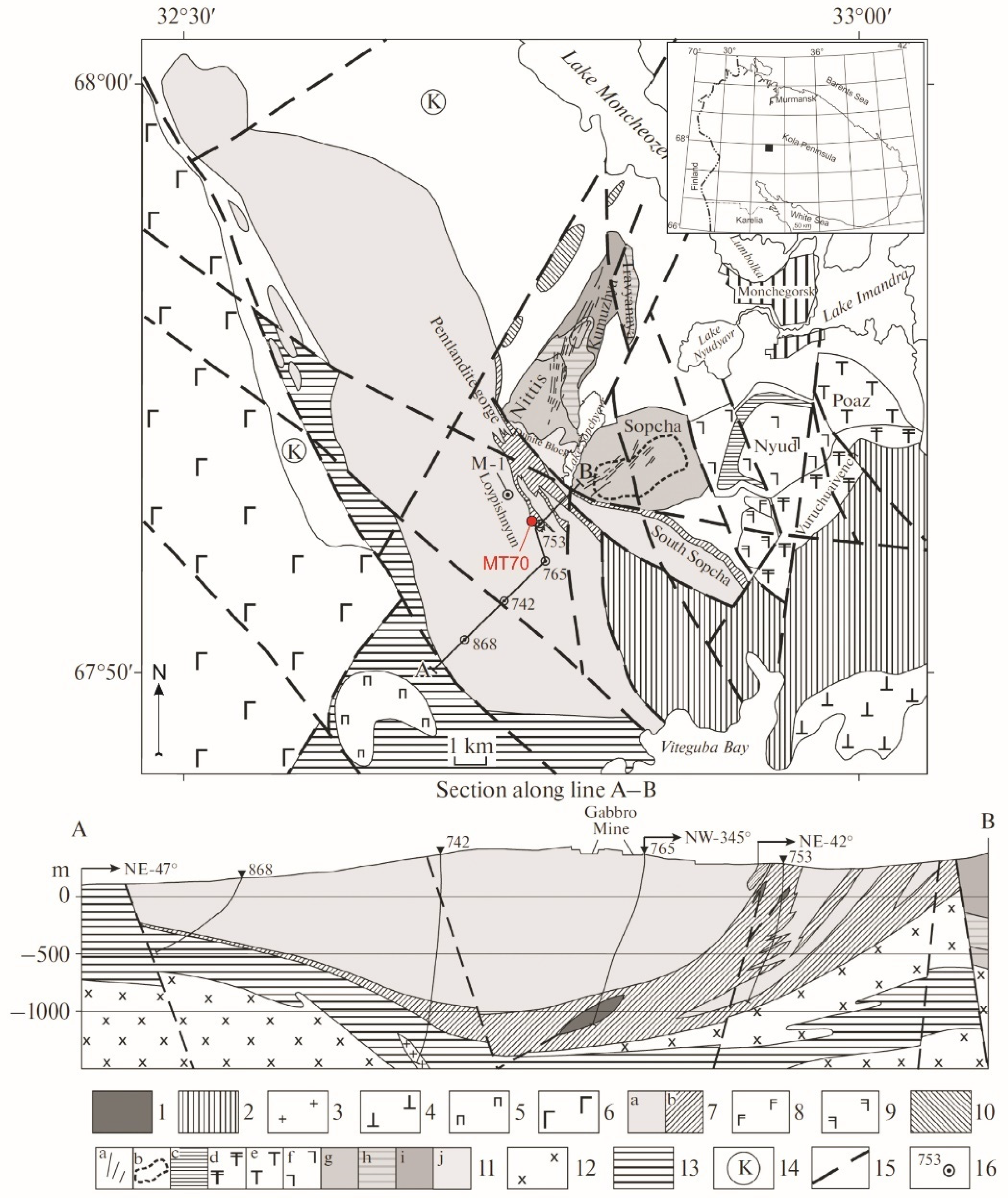
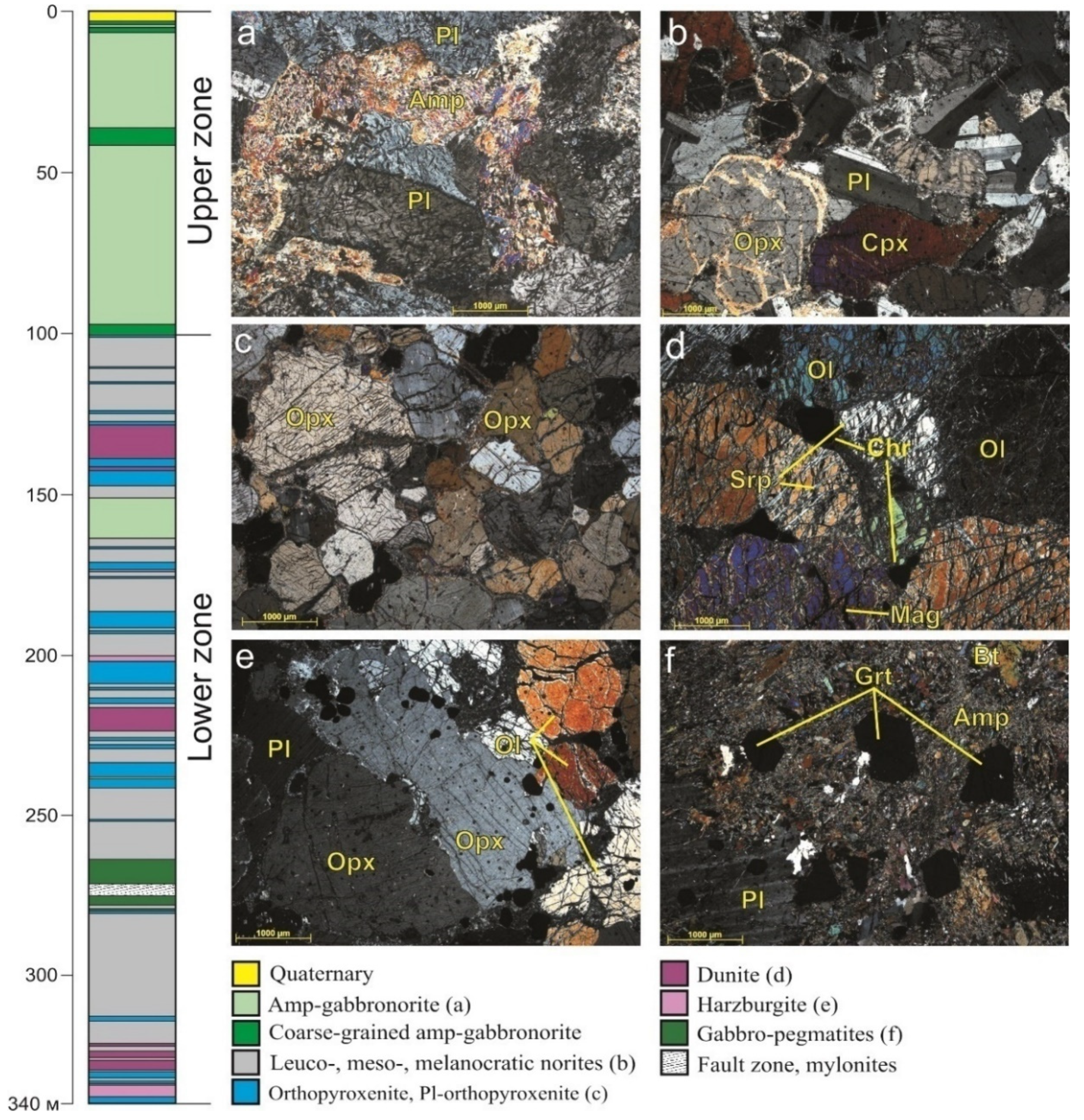
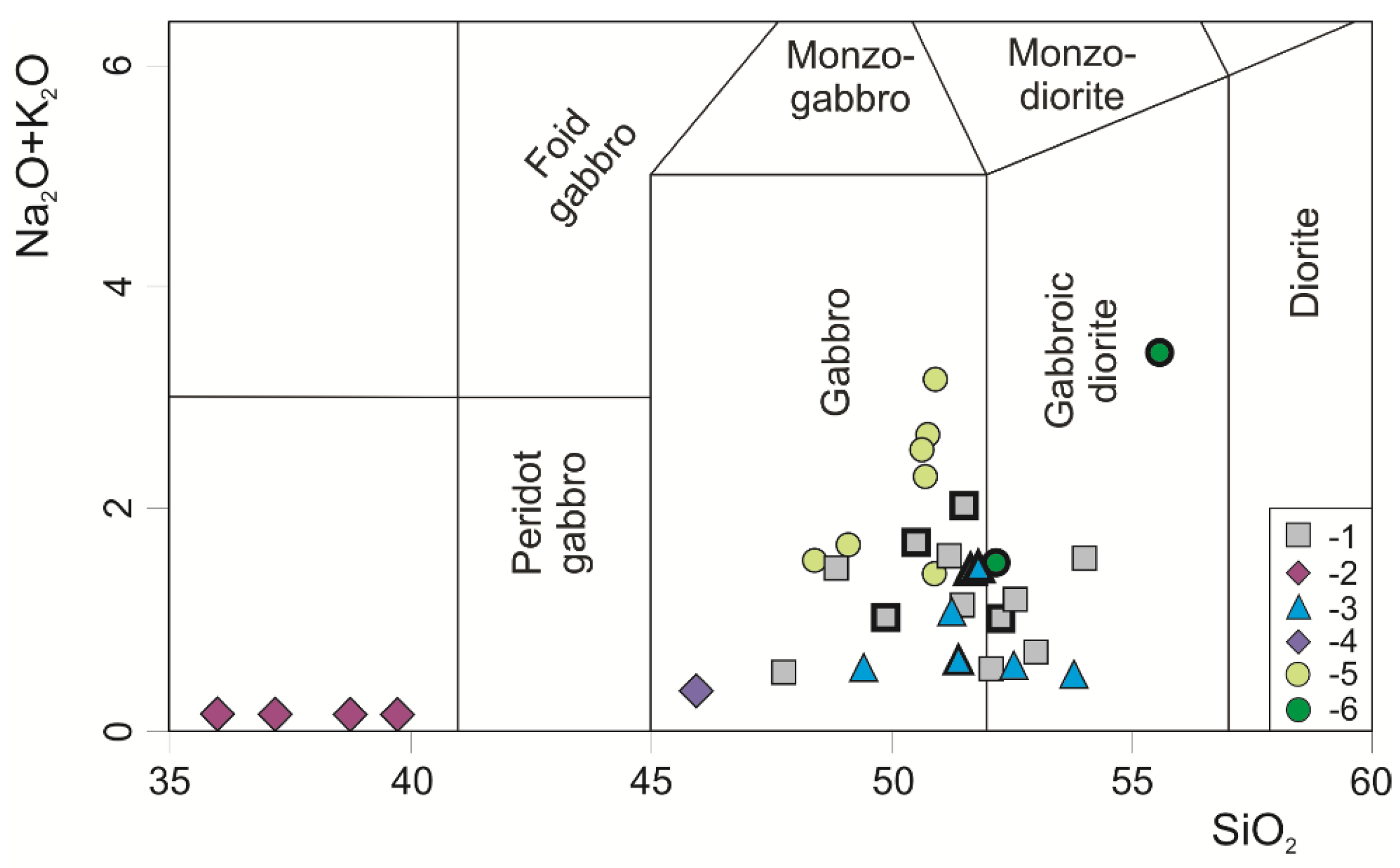
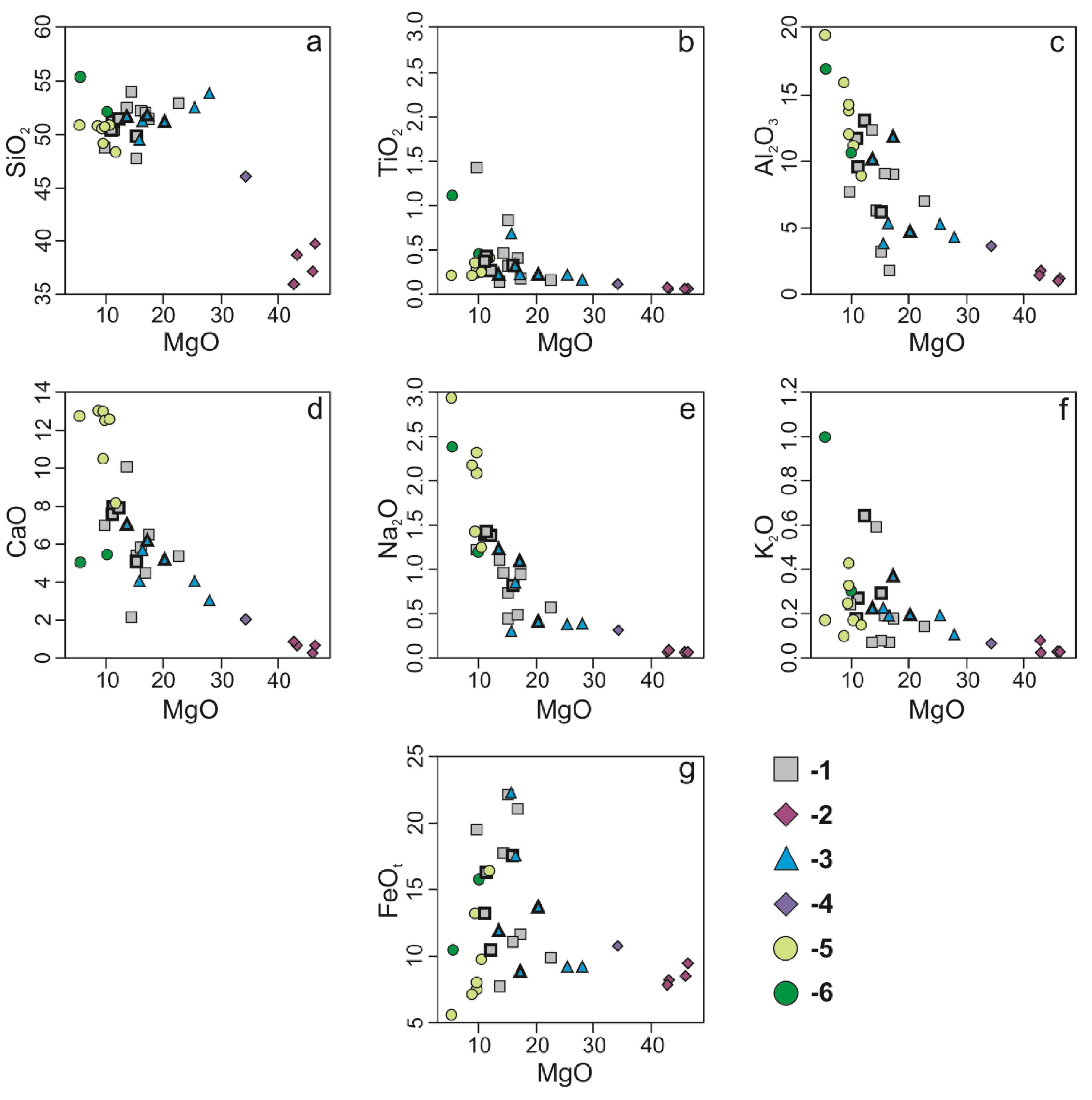

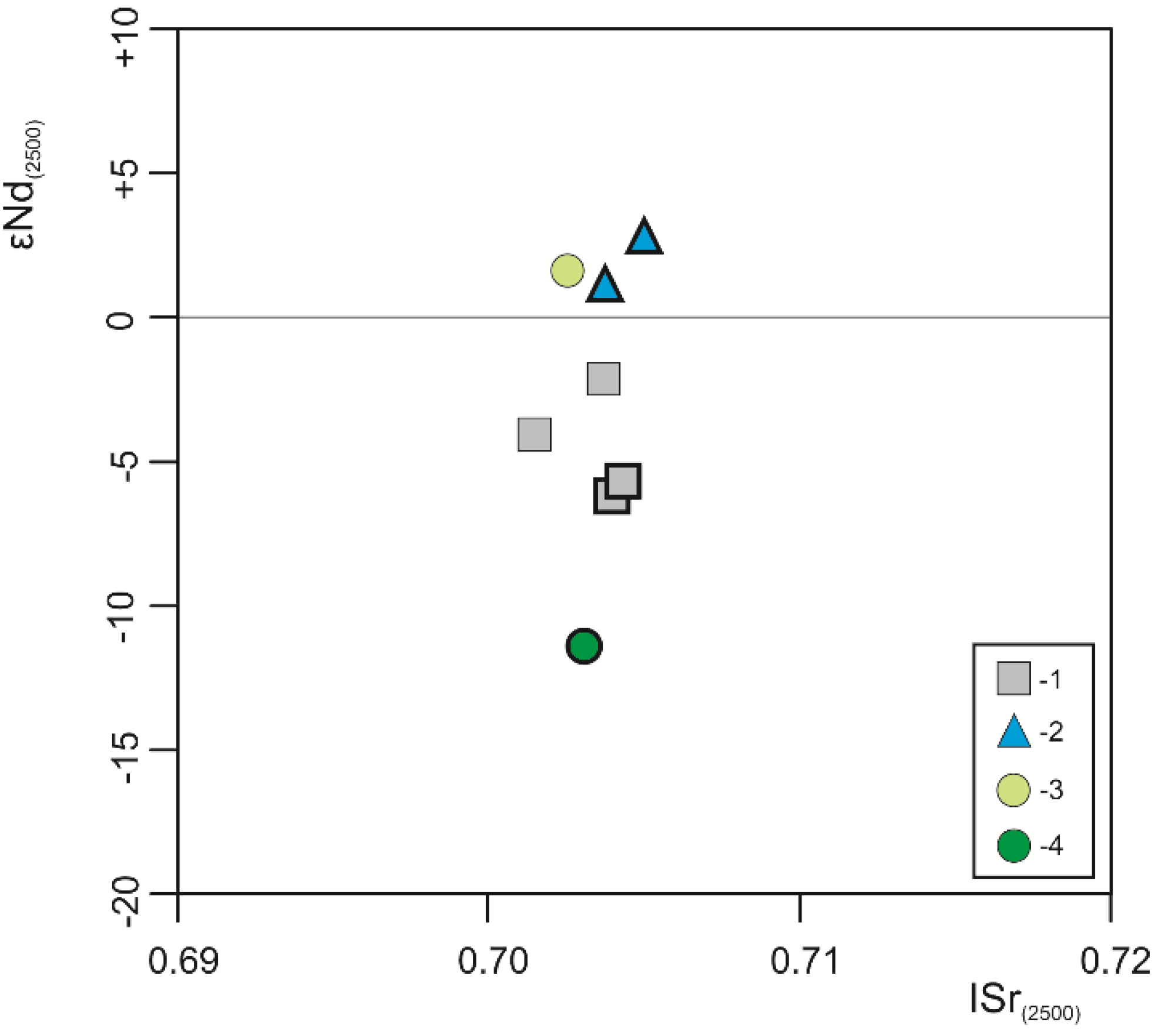
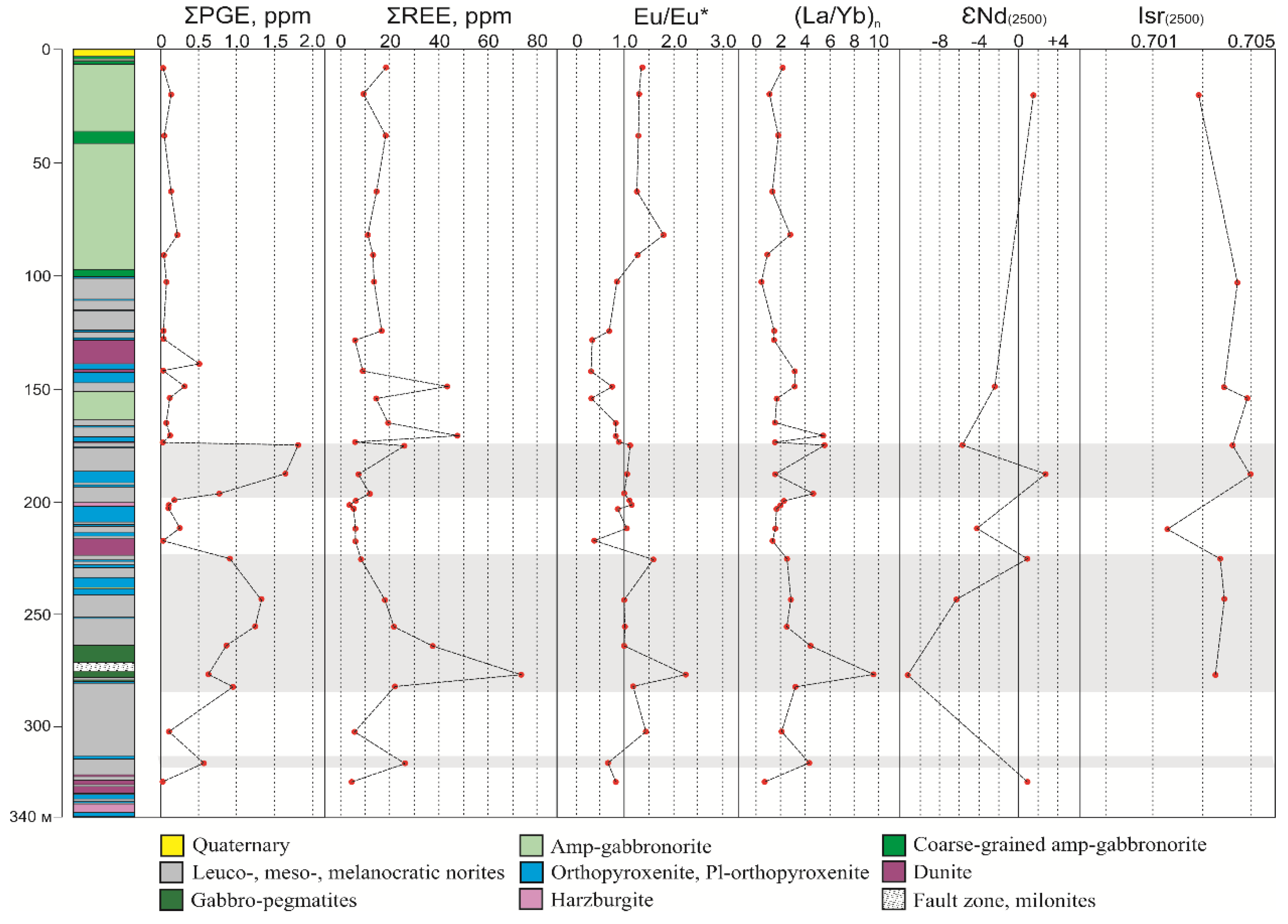

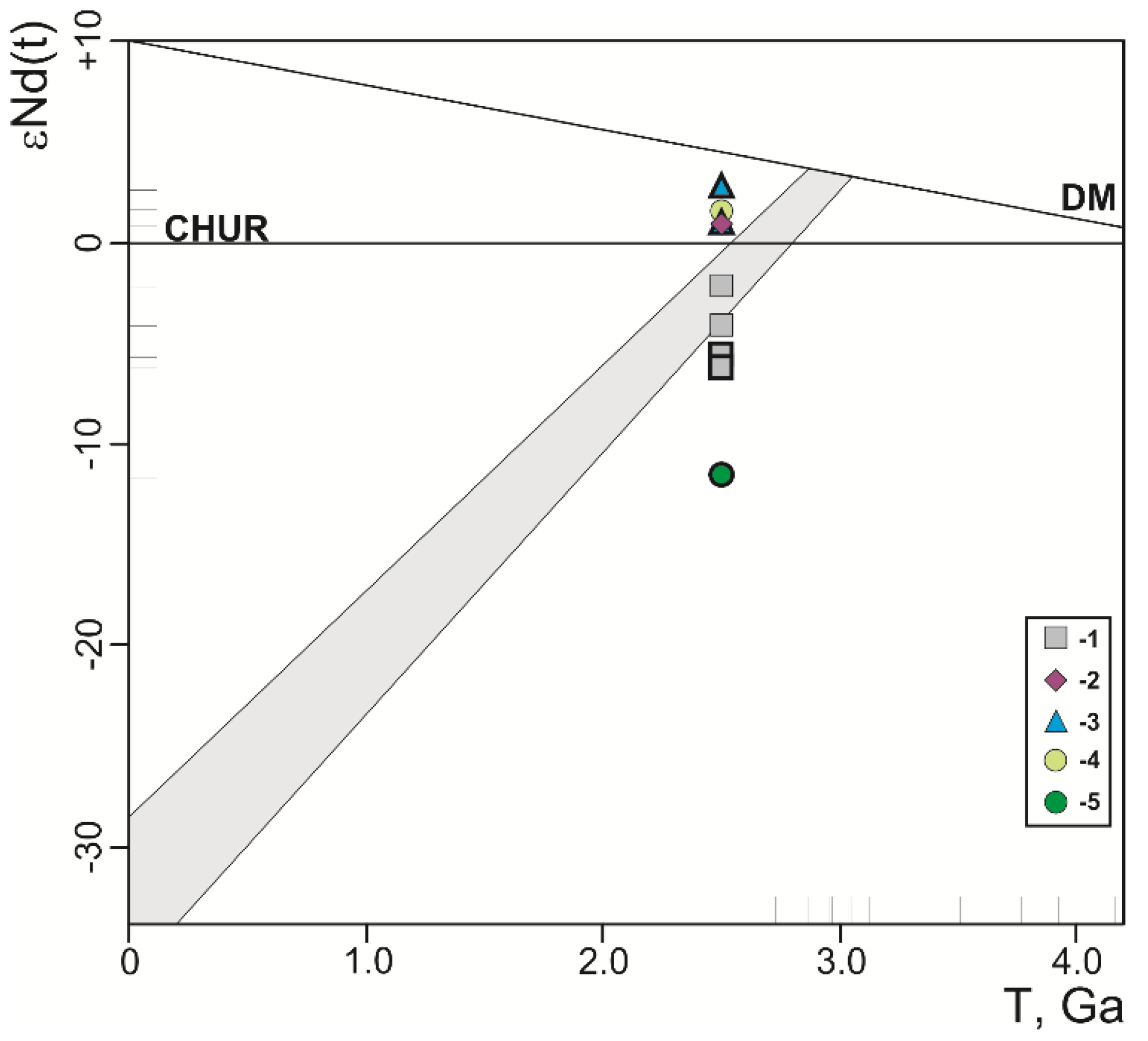
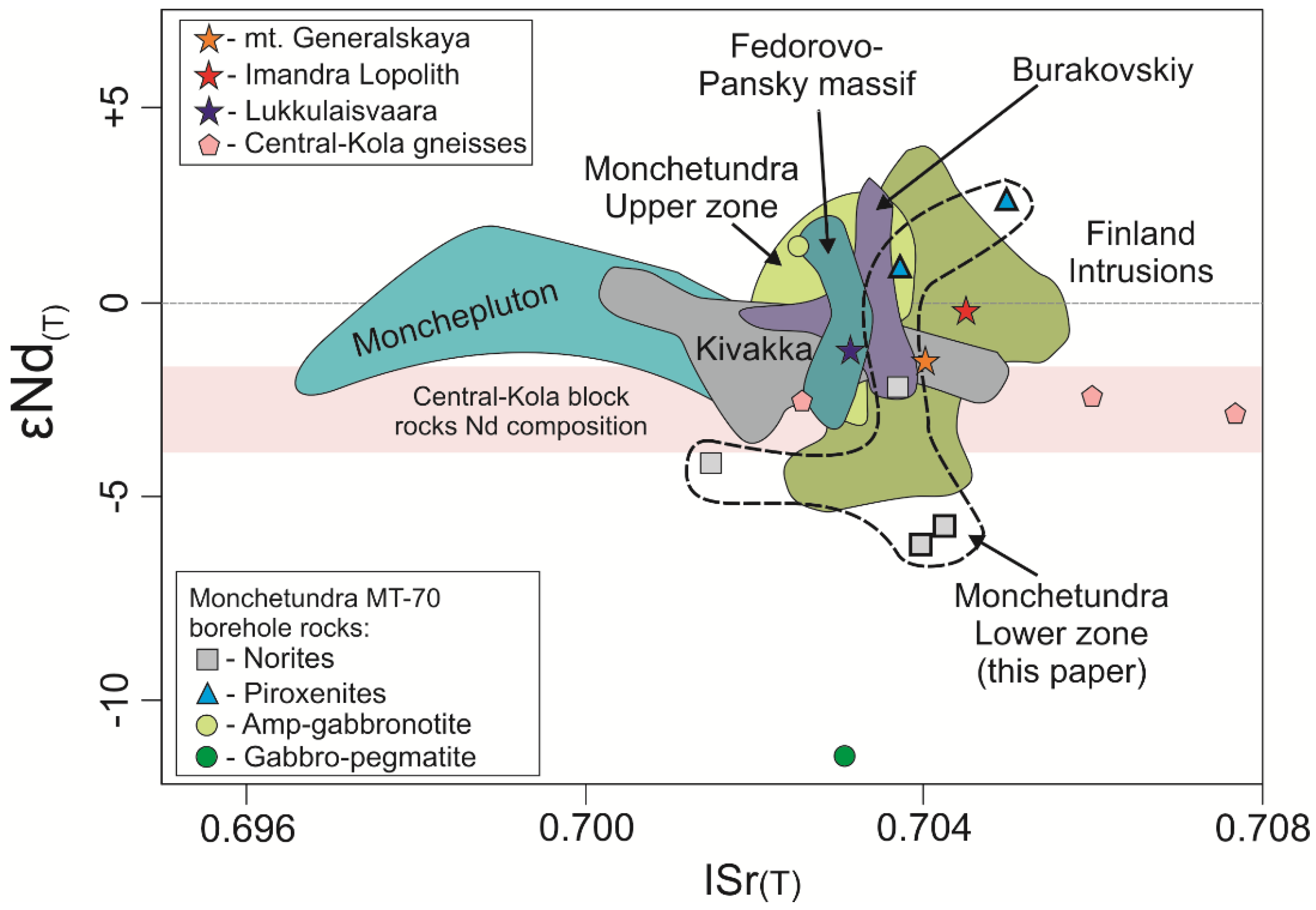
| Sample | Petrography | Ru, ppm | Rh, ppm | Pd, ppm | Ir, ppm | Pt, ppm | Total | Pd/Pt |
|---|---|---|---|---|---|---|---|---|
| 70/9 | AGN | <l.d. | <l.d. | 0.049 | <l.d. | 0.025 | 0.07 | 1.96 |
| 70/21 | AGN | <l.d. | 0.006 | 0.150 | <l.d. | 0.010 | 0.17 | 15.00 |
| 70/40 | AGN | <l.d. | <l.d. | 0.036 | <l.d. | 0.004 | 0.04 | 9.23 |
| 70/62 | AGN | <l.d. | 0.003 | 0.150 | <l.d. | 0.008 | 0.16 | 20.00 |
| 70/81 | AGN | <l.d. | 0.004 | 0.190 | <l.d. | 0.018 | 0.21 | 10.56 |
| 70/93 | AGN | <l.d. | <l.d. | 0.070 | <l.d. | 0.002 | 0.07 | 29.17 |
| 70/104 | N | <l.d. | <l.d. | 0.054 | <l.d. | 0.034 | 0.09 | 1.59 |
| 70/127 | PX | <l.d. | <l.d. | 0.039 | <l.d. | 0.018 | 0.06 | 2.17 |
| 70/127.6 | N | <l.d. | <l.d. | 0.031 | <l.d. | 0.014 | 0.05 | 2.21 |
| 70/129 | DN | 0.011 | <l.d. | 0.010 | 0.004 | 0.006 | 0.03 | 1.75 |
| 70/137 | DN | 0.013 | <l.d. | 0.004 | 0.004 | 0.003 | 0.02 | 1.39 |
| 70/151 | N | <l.d. | 0.005 | 0.190 | 0.002 | 0.100 | 0.30 | 1.90 |
| 70/157 | AGN | <l.d. | 0.002 | 0.130 | <l.d. | 0.004 | 0.14 | 35.14 |
| 70/165 | PX | <l.d. | <l.d. | 0.056 | <l.d. | 0.037 | 0.09 | 1.51 |
| 70/170 | N | <l.d. | 0.003 | 0.110 | <l.d. | 0.044 | 0.16 | 2.50 |
| 70/172 | PX | <l.d. | 0.003 | 0.053 | <l.d. | 0.024 | 0.08 | 2.21 |
| 70/177 | N | 0.005 | 0.042 | 1.350 | 0.008 | 0.400 | 1.80 | 3.38 |
| 70/189 | PX | 0.005 | 0.029 | 0.970 | 0.007 | 0.600 | 1.61 | 1.62 |
| 70/194 | PX | 0.003 | 0.021 | 0.590 | 0.005 | 0.170 | 0.79 | 3.47 |
| 70/196 | N | <l.d. | 0.004 | 0.160 | <l.d. | 0.033 | 0.20 | 4.85 |
| 70/200 | HB | 0.006 | 0.005 | 0.100 | 0.002 | 0.047 | 0.16 | 2.13 |
| 70/204 | PX | 0.012 | 0.005 | 0.086 | 0.005 | 0.055 | 0.16 | 1.56 |
| 70/214 | N | <l.d. | 0.006 | 0.180 | <l.d. | 0.048 | 0.23 | 3.75 |
| 70/219 | DN | 0.008 | <l.d. | 0.007 | <l.d. | 0.008 | 0.02 | 0.86 |
| 70/225 | PX | 0.003 | 0.016 | 0.570 | 0.004 | 0.300 | 0.89 | 1.90 |
| 70/245 | N | 0.005 | 0.028 | 0.800 | 0.007 | 0.470 | 1.31 | 1.70 |
| 70/259 | N | 0.003 | 0.025 | 0.790 | 0.005 | 0.430 | 1.25 | 1.84 |
| 70/264 | GP | <l.d. | 0.027 | 0.520 | 0.004 | 0.290 | 0.84 | 1.79 |
| 70/275 | GP | 0.003 | 0.048 | 0.390 | 0.003 | 0.170 | 0.61 | 2.29 |
| 70/281 | N | <l.d. | 0.660 | 0.160 | 0.008 | 0.079 | 0.91 | 2.03 |
| 70/303 | N | <l.d. | <l.d. | 0.094 | <l.d. | 0.015 | 0.11 | 6.27 |
| 70/319 | N | 0.003 | 0.005 | 0.370 | 0.002 | 0.230 | 0.61 | 1.61 |
| 70/324 | DN | 0.008 | 0.005 | 0.034 | 0.003 | 0.010 | 0.06 | 3.58 |
| Sample | Petrography | Rb, ppm | Sr, ppm | 87Rb/86Sr | 87Sr/86Sr | ±2σ abs. | ISr(2500) | Sm, ppm | Nd, ppm | 147Sm/144Nd | 143Nd/144Nd | ±2σ abs. | εNd(2500) |
|---|---|---|---|---|---|---|---|---|---|---|---|---|---|
| 70/21 | Amp-Gabbronorite | 1.08 | 251.91 | 0.0121 | 0.70297 | 0.00019 | 0.70253 | 0.48 | 1.66 | 0.1731 | 0.512334 | 0.000017 | 1.60 |
| 70/104 | Norite | 0.65 | 33.87 | 0.0541 | 0.70629 | 0.00022 | 0.70433 | - | - | - | - | - | - |
| 70/151 | Norite | 6.98 | 132.61 | 0.1486 | 0.70907 | 0.00016 | 0.70370 | 1.72 | 7.86 | 0.1319 | 0.511464 | 0.000004 | -2.16 |
| 70/157 | Amp-Gabbronorite | 9.29 | 264.00 | 0.0993 | 0.70853 | 0.00015 | 0.70494 | - | - | - | - | - | - |
| 70/177 | Ore-Norite | 24.72 | 187.74 | 0.3715 | 0.71769 | 0.00018 | 0.70426 | 0.81 | 3.58 | 0.1361 | 0.511351 | 0.000011 | −5.72 |
| 70/189 | Ore-Pyroxenite | 5.45 | 49.22 | 0.3123 | 0.71627 | 0.00028 | 0.70498 | 0.27 | 1.10 | 0.1489 | 0.511987 | 0.000016 | 2.61 |
| 70/214 | Norite | 4.51 | 77.12 | 0.1650 | 0.70745 | 0.00014 | 0.70149 | 0.27 | 1.02 | 0.1616 | 0.511853 | 0.000019 | −4.13 |
| 70/225 | Ore-Pyroxenite | 5.82 | 142.04 | 0.1157 | 0.70791 | 0.00016 | 0.70373 | 0.31 | 1.35 | 0.1378 | 0.511716 | 0.000029 | 0.88 |
| 70/259 | Ore-Norite | 9.09 | 156.30 | 0.1641 | 0.70990 | 0.00021 | 0.70397 | 0.99 | 3.65 | 0.1646 | 0.511797 | 0.000010 | −6.20 |
| 70/275 | Gabbro-pegmatite | 63.94 | 407.30 | 0.4429 | 0.71908 | 0.00015 | 0.70340 | 1.90 | 9.06 | 0.1271 | 0.510901 | 0.000080 | −11.64 |
| 70/325 | Dunite | 0.46 | 3.25 | 0.4056 | 0.70698 | 0.00022 | - | 0.06 | 0.22 | 0.1534 | 0.511970 | 0.000050 | 0.81 |
© 2020 by the authors. Licensee MDPI, Basel, Switzerland. This article is an open access article distributed under the terms and conditions of the Creative Commons Attribution (CC BY) license (http://creativecommons.org/licenses/by/4.0/).
Share and Cite
Kunakkuzin, E.; Borisenko, E.; Nerovich, L.; Serov, P.; Bayanova, T.; Elizarov, D. The Origin and Evolution of Ore-Bearing Rocks in the Loypishnun Deposit (Monchetundra Massif, NE Fennoscandian Shield): Isotope Nd-Sr and REE Geochemical Data. Minerals 2020, 10, 286. https://doi.org/10.3390/min10030286
Kunakkuzin E, Borisenko E, Nerovich L, Serov P, Bayanova T, Elizarov D. The Origin and Evolution of Ore-Bearing Rocks in the Loypishnun Deposit (Monchetundra Massif, NE Fennoscandian Shield): Isotope Nd-Sr and REE Geochemical Data. Minerals. 2020; 10(3):286. https://doi.org/10.3390/min10030286
Chicago/Turabian StyleKunakkuzin, Evgeniy, Elena Borisenko, Luydmila Nerovich, Pavel Serov, Tamara Bayanova, and Dmitry Elizarov. 2020. "The Origin and Evolution of Ore-Bearing Rocks in the Loypishnun Deposit (Monchetundra Massif, NE Fennoscandian Shield): Isotope Nd-Sr and REE Geochemical Data" Minerals 10, no. 3: 286. https://doi.org/10.3390/min10030286
APA StyleKunakkuzin, E., Borisenko, E., Nerovich, L., Serov, P., Bayanova, T., & Elizarov, D. (2020). The Origin and Evolution of Ore-Bearing Rocks in the Loypishnun Deposit (Monchetundra Massif, NE Fennoscandian Shield): Isotope Nd-Sr and REE Geochemical Data. Minerals, 10(3), 286. https://doi.org/10.3390/min10030286





